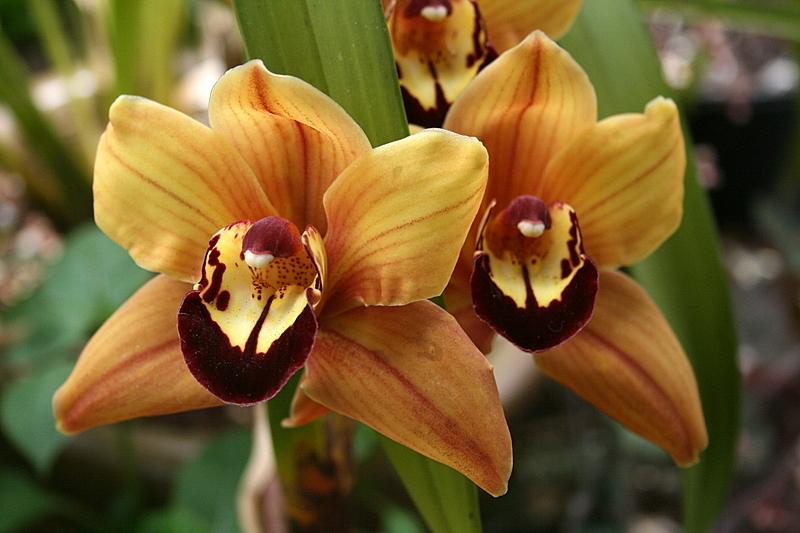Gardeners all across the US envy our Northern California climate. Warm days and cool nights make this a perfect spot not only for human habitation, but also for growing cymbidium orchids.

Many of the large-flowered species and their hybrids (the majority of traditional Cymbidiums) need a diurnal variation (day vs. night temperature change) of at least 18°F/10°C to produce their spectacular flowers. They don't like excessive heat (above about 86°F), although they can easily tolerate up to 95°F/35°C with the appropriate care. Likewise, they will often tolerate a light frost, although may show signs of damage on the leaves and should be protected once it gets close to freezing (i.e. below 40°F).
The smaller tropical species have different requirements. They dislike temperatures below about 50°F/10°C and will handle temperatures around 86-95°F/30-35°C without much trouble. They have less need for a diurnal variation to make them flower, although some still need around 9°F/5°C variation to initiate spiking.
You can tell if your Cymbidiums are getting too much or not enough light by the leaf color. The foliage should be a bright green color. Dark green indicates not enough light, while yellow or burning of the leaves indicates too much.
These plants are stunning in bloom and typically have 10 to 30 blooms on a single spike. Flowers on most modern hybrids will last 8 or more weeks on the plant, and usually 4 weeks if cut just after opening and displayed indoors in a cool location. There are exceptions, of course, with some species and their hybrids being unsuitable for cut flowers.
Individual flowers range in size from 1 to 6 inches in diameter, depending on the variety. Plant breeders have developed a wide spectrum of colors, with almost every color (excluding black and blue) now available.
If you grow your Cymbidiums outdoors, protect the flower spikes and buds from hungry snails and other pests. Ensure good airflow around the developing buds and opening flowers to minimise the likelihood of botrytis or other fungi damaging the blooms.
Keep in mind that light and water are the main reasons why Cymbidiums won't bloom, rather than insufficient fertilizer. If a plant is struggling, try to address any issues with light, water and draininage rather than fertilizing it.
The other is dividing or replacing the media, which is required either when plants need to be split up because they are too large, or the media has broken down and needs to be replaced. This should only be done after flowering and before temperatures get too high in summer.
When dividing the plants, keep a minimum of three healthy pseudobulbs per division. Try to avoid damaging the healthy roots (these will be lighter in color and moderately firm to touch) in the process. The selected bulbs should be solid (not squishy) and no more than one-third of the division should be leafless backbulbs. Any excess backbulbs leftover from dividing your plant can be potted up separately to try to grow new plants from.
Place the divisions in fresh orchid media (not potting soil!) in a pot that allows only 2-3 inches between the bulbs and the side of the pot, as Cymbidiums do not like being excessively overpotted. Your choice of orchid media depends on how often you water; the key requirement is that has excellent drainage and allows oxygen to the roots. Whatever you choose must not remain sodden between waterings. Many growers will use orchid bark (treated pine bark) for their plants, which allows for an open and airy mix. Perlite and coir is another option. Spaghnum moss and peat moss can be used, but are much more difficult to get right and run the risk of root rot.
In drier climates, you can use a shallow saucer under your Cymbidium pots. This helps particularly with small plants that can dry out quickly. However, if you have a medium that stays moist for a significant period of time, do not use a saucer.